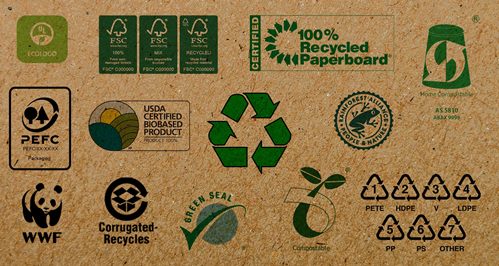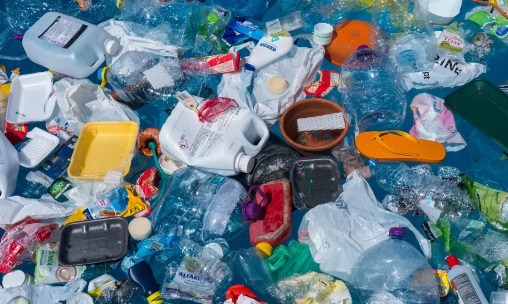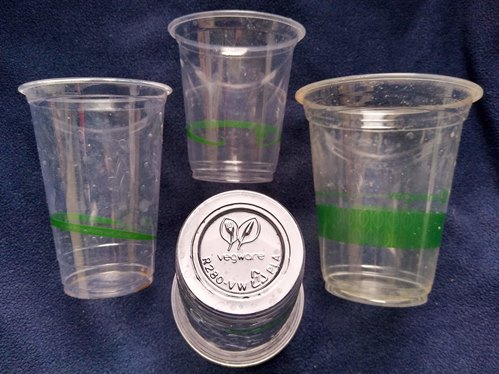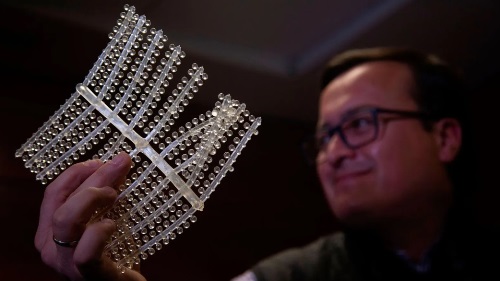
Examples of Green Packaging Symbols (https://www.zenpack.us/blog/wp-content/uploads/2021/11/recycling-symbols3-1920x1024.jpeg)
The push for green packaging has been fast and industry-wide. There exist countless new packaging products that fill a wide variety of niches. There are recyclable packages, repurposable packages, compostable packages, and environmentally safe packages. Yet there is no unifying body that regulates all this packaging worldwide. You have likely seen many of the symbols above, but do you know what they stand for, what they are meant to convey? The truth is many of them are unclear and require research to understand what they mean. For the average consumer, this likely results in the package being discarded along with the rest of their trash, nullifying many of the benefits of green packaging. In fact, in America alone, only 8 percent of plastics discarded are recycled yearly, a shockingly low number. The problem of sustainability will not be solved through green packaging. The consumer must be educated on these matters. It is not enough to place recycling containers in public spaces, rather people need to also understand the best way to discard their waste.

Plastic Contamination in the Ocean (https://i.guim.co.uk/img/media/0a0548bdceab9c5ada6694cca35b692cce9cf4cc/0_158_4724_2835/master/4724.jpg?width=1200&quality=85&auto=format&fit=max&s=646e9c4b5f0c8822caf6bce9f64ff811)
Plastics have long been used in packaging, all the way from exterior covers to the inside of packages. They are highly customizable and have many properties that make them very popular for all sorts of packaging. The downfall of plastics comes with their production and post-packaging life. Most plastics in use today are recyclable, however, that does not truly offset the harm their production causes. Plastics are made from petroleum, the production of which is one of the most contaminating and harmful to the earth. Plastics can take hundreds of years to break down into their most simple components when not discarded properly. Every year, hundreds of tons of plastics end up in landfills, and only a small percentage of them end up in recycling plants, a concerning figure. But why is this? The problem comes down to a combination of lack of education and improper facilities for enabling recycling.
How often do you see a recycling bin while walking down the street? On the same street, you will likely find several trash bins. Many recycling centers are in inconvenient locations for most people. People love convenience, so if it comes down to it, most will throw away their plastics in a trash can instead of making the effort to find a recycling bin. Trash is simple, you throw it away and that is that. Recycling is a whole lot more complicated and often results in recyclable products being thrown away. Another problem that arises with recycling, at least in the United States, is that programs are not the same everywhere. When I lived in Georgia for example, there was no glass recycling program in place. I could return my grocery bags to the store to be recycled but they only took bags back. If I have any other plastic, I would have to take it elsewhere. Another issue that arises due to the lack of proper information is people will try to recycle non-recyclable objects such as straws or food containers. Although they are made from recyclable materials, they are not recyclable. This means they must be sorted out and many times this results in large batches of recyclable waste being processed in other ways. The lack of consistency in local recycling programs leads to confusion that could be easily avoided by standardizing these programs. The average person will not understand these differences and contaminate an otherwise perfectly recyclable load of waste.

Greenwashing (https://www.ecowatch.com/wp-content/uploads/2021/10/414696264-origin.jpg)
World governments are, for lack of a better phrase, not stepping up to the plate when it comes to overhauling recycling programs. This in turn shifts the weight to companies. In most cases, companies only promote and encourage recycling as far as it improves their image and makes themselves look environmentally conscious. Their actions are only surface-level and responsorial and often make things more complicated for consumers. Many companies pride themselves on delivering items and packaging that can be technically recycled, but often requires breaking down the packaging and taking these components to various recycling centers. This leaves a sour taste in the mouth of many consumers, as the companies are shifting that responsibility onto them. As we mentioned earlier, this difficulty in recycling leads to many recyclable waste products being discarded with normal waste. So, these solutions are not solutions and are only a dress-up game put on by companies to greenwash their images. It is not truly about helping the environment, only appearing as if they are. In most situations, companies simply shift the burden onto customers to manage their enormous packaging footprints. Amazon, for example, has a website to find recycling locations for some of its mailers. Amazon made a huge deal about their supposedly sustainable new recyclable mailers. Although Amazon claims its mailers are recyclable, they are infamous for gumming up many recycling centers sorting machines. Companies and governments must realize that most people want to do their part to help the environment, but there needs to be an appropriate framework and education for recycling to work.

Cups made out of biodegradable plastic (https://upload.wikimedia.org/wikipedia/commons/thumb/c/c6/Cmglee_PLA_cups.jpg/1920px-Cmglee_PLA_cups.jpg?1651882605514)
There are, of course, other alternatives or supplements to recycling. Due to the prevalence of plastic in packaging, there have been countless attempts to reduce the environmental impact of plastic materials, both during production and post end life. A popular solution has been biodegradable plastics. These are plastics that can be decomposed by microorganisms into water, carbon dioxide, and biomass. They are commonly produced with renewable raw materials, micro-organisms, petrochemicals, or a combination of all three. Biodegradable plastics are now commonly manufactured from crop byproducts such as corn. The huge benefit of biodegradable plastics is that they break down in nature faster than traditional plastics. This is huge because it means that even if they end up at a landfill, biodegradable plastics will still decompose and not remain polluting for hundreds of years. Another key benefit of biodegradable plastics is their ability to be recycled. Traditional plastics can only be recycled a certain number of times and often require longer and more expensive recycling processes. Biodegradable plastics are a lot easier to recycle and can be put through the cycle many more times.
That is not to say that biodegradable plastics are the perfect solution for all our plastic pollution issues. Since some bioplastics are made from crops such as corn, there exists the possibility that they may be contaminated by pesticides. Because they are many bioplastics made from crops, this puts a strain on crop growers. There is already a growing human population, which results in hunger and using some crops for plastic production will only exacerbate this growing problem. Another critical and recurring issue is that they cannot be mixed with nonbiodegradable plastics when it comes to recycling. If they are mixed there is a high chance of contamination requiring further processing before they can be recycled. This costs money and time, making recycling these types of plastics less lucrative. The last thing we would want is to have fewer recyclers. Saturation in the market is very low and we need more companies and governments to step up and provide a recycling framework. These plastics tend to be more expensive than their regular plastic counterparts, making them less likely to be used. Biodegradable plastics also do not solve the problem of ocean contamination. These kinds of plastics indeed need water to decompose, the truth is that many of the ocean temperatures are much too low to begin the process.
The generalization of much of the knowledge required for recycling is a huge hindrance to the whole system. Bioplastics, although at surface level seem to solve many of our problems with plastics, are not a magical solution to everything. They require special methods to be properly discarded, methods that the public does not understand. This does not solve the problem of recycling, instead, it adds a layer of complexity to the system. They cannot be recycled with traditional plastic waste and must instead be processed on a separate line. Many of the processes required to recycle these types of plastic require expensive machinery that is not yet readily available. So even if they are rolled out on a large scale, the recycling plant infrastructure is still ill-equipped to handle these new biodegradable plastics. This so-called solution is creating a whole new set of problems that have yet to be adequately solved. That is all without touching on the subject of having to educate the population on how to properly discard a whole other type of plastic when most do not even know how to properly discard the plastics that we already have.

A new plastic that dissolves completely in water (https://ychef.files.bbci.co.uk/1600x900/p07shfdw.webp)
The issue of standardization in the labeling of packaging has been recently put into the spotlight. There are many products labeled as compostable. Although they are not lying, there are usually caveats to these labels. Many of these so-called compostable bags are not compostable at home, or if they are, they break down over years, unfeasible for home compost piles. They require an environment that can only be created in industrial compost piles. Oxo-biodegradable plastics are becoming a huge issue. These are plastics that break down in an oxidation process. The issue is that many times they do not break down to their most basic components. Instead, they break down into small particles known as microplastics. Microplastics are all over our environment already and we have only just begun to discover the impact that they have on our bodies and the environment. The EU has already begun to draft a proposal that would ban oxo-biodegradable plastics out of fear of the microplastics that they may create and disperse into the environment. A key distinction is that not all biodegradable plastics are biobased, but all bio-based plastics are biodegradable. Biodegradable plastics can be made from non-organic materials such as petroleum, but bio-based plastics must be made from organic materials. Bio-based plastics are more sustainable.
The push for sustainable materials is not enough, we must educate the public on how to properly dispose of all their waste. Recyclable material is not living up to its recyclable name if it ends in the landfill or is mixed up with non-recyclables. What good is recycling if the infrastructure is just not there? We must make educated choices with our packaging material choices and properly discard them. We must not follow trends blindly without doing research. Not all bio-degradable plastics are created equally. Many still require complicated machinery and processes to properly dispose of. Many of these are simply not widely available. Labels must also be standardized. Just because a cup claims it is compostable does not mean that you can toss it into a compost pile at home. Companies should at least inform consumers on how to properly discard their products. The over-complication and shift of responsibility onto the consumer will not end well. It is time for our governments to take charge and put robust recycling and waste management infrastructures into place. Sustainability is not a one-step type of deal. For true sustainability, we must account for the entire life of the product, from its inception to the end of its useful life. Information is a very strong tool, but it does consumers no good if they cannot discard of their waste in the proper channels because they are not available to them.
References
https://makeitclear.com/insight/recycling-and-sustainability-labels-explained
https://www.nspackaging.com/comment/recycling-symbols-explained-green-dot-mobius/
https://myelement.co.uk/blogs/news/compostable-recycling-symbols-explained-a-2021-guide-to-uk-packaging
https://grist.org/accountability/energy-department-slammed-for-funding-false-plastics-solutions/
https://www.forbes.com/sites/blakemorgan/2021/04/21/why-is-it-so-hard-to-recycle/?sh=48186b63b778
https://www.conserve-energy-future.com/advantages-disadvantages-uses-biodegradable-plastics.php
https://www.bbc.com/future/article/20191030-why-biodegradables-wont-solve-the-plastic-crisis


































